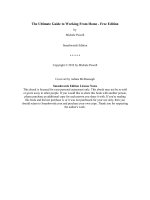forex ultimate guide to price action trading
Bạn đang xem bản rút gọn của tài liệu. Xem và tải ngay bản đầy đủ của tài liệu tại đây (3.87 MB, 129 trang )
Copyright 2014 © www.swing-trading-strategies.com
Page 1
TABLE OF CONTENTS
CHAPTER 1:
INTRODUCTION (Page 4)
CHAPTER 2:
WHAT IS PRICE ACTION? (Page 6)
CHAPTER 3:
MASS PSYCHOLOGY IN TRADING (Page 15)
CHAPTER 4:
PRICE CHART (Page 18)
CHAPTER 5:
TRENDS (Page 32)
CHAPTER 6:
REVERSALS AND CONTINUATION (Page 37)
CHAPTER 7:
UNDERSTANDING MARKET SWINGS (Page 40)
CHAPTER 8:
HOW TO TRADE SUPPORT AND RESISTANCE LEVELS (Page 44)
CHAPTER 9:
HOW TO TRADE CHANNELS (Page 49)
CHAPTER 10:
NINE (9) CHART PATTERNS EVERY TRADER NEEDS TO KNOW (Page 52)
CHAPTER 11:
NINE (9) CANDLESTICK PATTERNS EVERY TRADER NEEDS TO KNOW (Page 81)
CHAPTER 12:
HOW TO TRADE FIBONACCI WITH PRICE ACTION (Page 93)
CHAPTER 13:
HOW TO TRADE TRENDLINES WITH PRICE ACTION (Page 98)
CHAPTER14:
HOW TO TRADE MOVING AVERAGES WITH PRICE ACTION (Page 103)
CHAPTER 15:
HOW TO TRADE CONFLUENCE WITH PRICE ACTION ( Page 110)
CHAPTER 16:
WHY YOU SHOULD USE MULTI-TIMEFRAME ANALYSIS (Page 116)
CHAPTER 17:
TRADE THE OBVIOUS (Page 124)
CHAPTER 18:
CLOSING REMARKS (Page 127)
Page 1
Page 2
Disclaimer
Trading foreign exchange on margin carries a high level of risk and may not be suitable for all investors. The high
degree of leverage can work against you as well as for you. Before deciding to trade foreign exchange you should
carefully consider your investment objectives, level of experience, and risk appetite. The possibility exists that you
could sustain a loss of some or all of your initial investment and, therefore, you should not invest money you
cannot afford to lose. You should be aware of all the risks associated with foreign exchange trading and seek
advice from an independent financial advisor if you have any doubts.
Opinions
Any opinions, news, research, analyses, prices or other information contained on this ebook is provided as general
market commentary and does not constitute investment advice. www.swing-trading-strategies.com will not accept
liability for any loss or damage including, without limitation, to any loss of profit which may arise directly or
indirectly from use of or reliance on such information.
Accuracy of Information
The content on this ebook is subject to change at any time without notice, and is provided for the sole purpose of
assisting traders to make independent investment decisions. www.swing-trading-strategies.com has taken
reasonable measures to ensure the accuracy of the information on the ebook; however, it does not guarantee
accuracy and will not accept liability for any loss or damage which may arise directly or indirectly from the content
of this ebook.
Page 3
CHAPTER 1: INTRODUCTION
To really understand price action means you need to study what happened in the
past. Then observe what is happening in the present and then predict where the
market will go next.
“Regardless of what you may think, all traders are forecasters, just like the
weatherman.”
The weatherman knows where the wind is blowing from, sees the high and low
pressure systems forming over the land, knows the temperature variation, cold
front, hot front…you know what I’m talking about, right? Then what does he do?
He will say something like “tomorrow, the weather in Edinburg will be mostly
cloudy, slight chance of shower and possibly sunny in the afternoon.”
How does he know that?
Copyright 2014 © www.swing-trading-strategies.com
Page 4
Well, from studying the past data and seeing what the current weather situation
is at the moment (and these days, their prediction is more reliable due advanced
computer models and weather satellites in space).
So traders are like that…
If we get the direction wrong, we lose money, we get it right, we make money.
Simple as that. So everything you are going to read here is about trying to get that
direction right before you place a trade.
Before you get started, these are some words that you may encounter:
Long= buy
Short= sell
Bulls= buyers
Bears= sellers
Bullish=if the market is up, it is said to be bullish (uptrend).
Bearish=if the market is down, it’s said to be bearish.
Bearish Candlestick=a candlestick that has opened higher and closed lower is said
to be bearish.
Bullish Candlestick=a candlestick that has opened lower and closed higher is said
to be a bullish candlestick.
Risk : Reward Ratio=if you risk $50 in a trade to make $150 then your risk: reward
is 1:3 which simply means you made 3 times more than your risked. This is an
example of risk: reward ratio.
Copyright 2014 © www.swing-trading-strategies.com
Page 5
CHAPTER 2: WHAT IS PRICE ACTION?
This is the basic definition of price action trading:
When traders make trading decisions based on repeated price patterns that once
formed, they indicate to the trader what direction the market is most likely to
move.
Price action trading uses tools like charts patterns, candlestick patterns,
trendlines, price bands, market swing structure like upswings and downswings,
support and resistance levels, consolidations, Fibonacci retracement levels, pivots
etc.
Generally, price action traders tend to ignore the fundamental analysis-the
underlying factor that moves the markets. Why? Because they believe everything
is already discounted for in the market price.
But there’s one thing I believe you should not ignore: major economic news
announcements like the Interest Rate decisions, Non-Farm Payroll, FOMC etc.
From my own experience and from what I’ve seen, I say this “the release of
economic news can be both a friend and an enemy for your trades.”
Here’s what I mean by that:
• If you did take a trade in line with the result of economic news release you
stand to make a lot more money very quickly in a very short time because
the release of the news often tends to move price very quickly either up or
down due to increased volatility.
• But if your trade was against the news, you can walk away with all your
profits wiped out or a loss and the loss can be huge because markets can
move so fast during that period that there’s also the chance that your stop
loss cannot be triggered.
Copyright 2014 © www.swing-trading-strategies.com
Page 6
The chart below shows and example of what can happen when there is major
forex fundamental news release:
This is one experience I will never forget. I traded a perfect price action setup, the
trade went as I anticipated but a few minutes later, the market dropped down
very quickly.
My stop loss was never triggered at the price level where I set initially.
I tried to close that trade as many times as I could but it was impossible to close
because the price was way down below where my stop loss price was! Price
jumped my stop loss.
Copyright 2014 © www.swing-trading-strategies.com
Page 7
I just stood there and watched helplessly. After what seemed like an eternity, the
trade was closed by broker at the worst possible price way-way-way- down
below!
That single trade nearly wiped out my trading account. Instead of losing 2% of my
trading account, I lost almost half of it. I did not understand and did not know
what happened that night to make the market move like that. I could not sleep
that night.
Later I found out that it was a major economic news release that moved the
market like that.
Now before I place a trade, I head over to this website here to check the news
calendar: />If there’s a valid trade setup but If I see that the time is close to a major news to
be announced, I will not enter. There are exceptions where I will take a trade if I
see that I can place my stop loss behind a major support or resistance level.
The high impact news are colour coded in Red. That’s what you look for(see figure
below):
Copyright 2014 © www.swing-trading-strategies.com
Page 8
Here’s what you can do:
1. If a valid trade setup happening, check with forexfactory.com to make sure
there are no major news announcements to be made soon that can impact
your trade.
2. If there’s news to be released you can do these 2 things: don’t trade until
after the news release and wait until markets starts trading normally again,
or if you decide to trade, trade small contracts because the market is very
volatile when the news is released. This can works for you or against you.
You need to know what you are doing during these times.
3. If you already have a trade that has been running (prior to the news release
time) for some time and in profit, think about moving stop loss tighter or
taking some profits off that table in case the market goes against you once
the news is released. In an ideal case, you would have taken this trade a
while ago and that the current market price is far away from your trade
entry price and you would have locked some profits already and if the
market moves in the direction of your trade after the news release, you will
make a lot of money.
Copyright 2014 © www.swing-trading-strategies.com
Page 9
3 Important Reasons Why You Should Be Trading Price Action
1. Price action represents collective human behaviour. Human behaviour in
the market creates some specific patterns on the charts. So price action
trading is really about understanding the psychology of the market using
those patterns. That’s why you see price hits support levels and bounces
back up. That’s why you see price hits resistance levels and heads down.
Why? Because of collective human reaction!
2. Price action gives structure to the forex market. You can’t predict with
100% accuracy where the market will go next. However with price action,
you can, to an extent predict where the market can potentially go. This is
because price action brings structure. So if you know the structure, you can
reduce the uncertainty to some extent and predict with some degree of
certainty where the market will go next.
3. Price Action helps reduce noise and false signals. If you are trading with
stochastic or CCI indicators etc, they tend to give too false signals. This is
also the case with many other indicators. Price action helps to reduce these
kinds of false signals. Price action is not immune to false signals but it is a
much better option than using other indicators…which are essentially
derived from the raw price data anyway. Price action also helps to reduce
“noise”. What is noise? Market noise is simply all the price data that
distorts the picture of the underlying trend… this is mostly due to small price
corrections as well as volatility.
One of the best ways to minimize market noise is to trade from larger timeframes
instead of trading from smaller timeframes. See the 2 charts below to see what I
mean:
Copyright 2014 © www.swing-trading-strategies.com
Page 10
And now, compare market noise in the 4hr chart (notice the white box on the
chart? That equates to the area of the 5min chart above!):
Smaller timeframes tend to have too much noise and many traders get lost
trading in smaller timeframes because they do not understand that the big trend
in the larger timeframe is the one that actually drives what happens in the smaller
timeframes.
Copyright 2014 © www.swing-trading-strategies.com
Page 11
But having said that, I do trade in smaller timeframes by using trading setups that
happen in larger timeframes. I do this to get in at a better price point and keep
my stop loss tight.
This is called multi-timeframe trading and I will also cover this on Chapter 16 to
show you exactly how it’s done.
Is Price Action Applicable To Any Other Market?
The answer is yes. All the price action trading stuff described here are applicable
to all markets.
In here, I will be mostly be talking in terms of using price action in the currency
market but as I’ve mentioned, the concepts are universal and can be applied to
any financial market.
Price Action Trading Allows You To Trade With An Edge
Price Action Trading is about trading with an edge. What is a trading edge?
Copyright 2014 © www.swing-trading-strategies.com
Page 12
Well, put simply it means you need to trade when the odds are in your favour.
Things like:
• Trading with the trend
• Trading With Price Action Using reliable chart patterns and candlestick
patterns.
• Trading using Support and resistance levels.
• Making your winners larger than your losing trades
• Trading only in larger timeframes
• Waiting patiently for the right trade setups and not chasing trades.
All these kinds of things above helps you to trade with an edge. They may not be
exiting and probably you’ve heard of these before but hey…this stuff is what
separates winners from losers.
What Price Action Trading Is Not
• Price action trading will not make
you rich…but price action trading
with proper risk management can
make you a profitable trader. Some
of you will go through this guide and
learn and make much money but
some of you will fail. That’s just the
way life is.
• Price action trading is not the holy
grail but it sure does beat using
other indicators (most of which
often lag and a derived from price
action anyway!).
• Price action trading will not make
you an overnight success. You need to put in the hard yards, observe and
Copyright 2014 © www.swing-trading-strategies.com
Page 13
see how price reacts and see those repetitive patterns and then have the
confidence to trade them then you will be rewarded for that.
If you are one of those that are going to learn from this course and apply it to
your forex trading, my hats off to you and I say “go and succeed.”
Chart time
You need chart time to understand Price Action. For some of you, it may take a
while for you to understand, while some of you may be very quick to learn.
Observe the price action of the market. Go back to the past and see how the
market had behaved. What caused it to behave that way? You cannot be a
confident price action trader until you do this.
If you could simply read the charts well enough to be able to enter at the exact
times when the move would take off and not come back, then you would have a
huge advantage.
Trend lines, specific candlestick patterns, specific chart patterns, Fibonacci
retracement levels & support and resistance levels…these are the tools I use to
trade.
If you put the time and effort into learning them, it won’t be long before you will
begin to understand and see how all these things fit together.
Start learning to trade naked price action.
Copyright 2014 © www.swing-trading-strategies.com
Page 14
CHAPTER 3: MASS PSYCHOLOGY IN TRADING
Here’s one thing about price action: it represents a collective human behaviour or
mass psychology.
Let me explain.
All human beings have evolved to respond to certain situations in certain ways.
And you can see this happen in the trading world as well:
The way multitude of traders think and react form patterns… repetitive price
patterns that one can see and then predict with a certain degree of accuracy
where the market will most likely go once that particular pattern is formed.
Copyright 2014 © www.swing-trading-strategies.com
Page 15
For example, if you see a major resistance level, price hits the level and forms a
‘shooting star’ a bearish reversal candlestick pattern. You can then say with a
greater degree of confidence that Price is going to head down.
Why?
Because there are so many trader watching that resistance level and they all know
that price has been rejected from this level on a previous one or two occasions and
that tells them that it is a resistance level and that they can also see that bearish
reversal candlestick formation… and guess what they will be waiting to do?
1. They will be waiting with their sell orders…not just one sell order but
thousands of them, some small and some big orders.
2. But on the other side of the coin is that trader that have bought at a low
price and now that the price is heading up to the resistance level, that’s
where most of their take profit levels are. So once they take their profits
around resistance levels, that means there are now less buyers now and
more sellers. The balance tips in the direction of the sellers and that’s how
the price is pushed back down from a resistance level.
Because price action is a representation of mass psychology…the markets are
moved by the activities of traders.
So price action trading is about understanding the psychology of the market using
those patterns and making a profit as a result.
There are 2 types of price action trading, the 100% Pure price action trading and
the not-so-pure price Action trading. Let me explain…
Pure Price Action Trading
Pure price action trading simply means 100% price action trading. No indicators
except price action alone.
Copyright 2014 © www.swing-trading-strategies.com
Page 16
Not-So-Pure Price Action Trading
This is when price action trading is used with other indicators and these other
indicators form part of the price action trading system. These indicators can be
trend indicators like moving averages or oscillators like stochastic indicator and
CCI. (Please don’t go googling CCI and stochastic indicators!)
Origin of Price Action Trading
Charles Dow is the guy credited to be the father of technical analysis. He came up
with the DOW Theory.
The theory tries to explain market behaviour and focuses on market trends. One
part of the theory is that the market price discounts everything. Therefore,
technical analysts use price charts and chart patterns to study market and don’t
really care about the fundament aspects of what move the markets.
I will cover this a little bit later when I talk about what are trends, how trends
begin (or end) in Chapter 5.
Copyright 2014 © www.swing-trading-strategies.com
Page 17
CHAPTER 4: PRICE AND CHARTS
Now, let’s study price in a little bit more detail…this stuff is for the
newbies…please skip this section if you think you know!
What is price?
Price is value given to a particular instrument usually in monetary terms and its
value is dependent on supply and demand.
• If the demand is more, price increases as more traders start buying and
driving prices up.
• Demand zones on your price charts are around support levels, that’s where
buyers come and start buying and driving prices up!
• If there is an oversupply, price falls as there are more seller and less buyers.
Copyright 2014 © www.swing-trading-strategies.com
Page 18
• Supply zones on your charts are on and around resistance levels where
sellers come in and drive the prices down due the fact that there are very
few buyers.
Every time you open up your charts, all you are seeing are the forces of supply
and demand at work!
If the market is going up, what does that tell you about the demand and supply
then? It means there’s a lot of demand for that instrument.
Or what if the marketing is going down then what does that tell you about the
demand and supply then? There’s a less demand and lots of supply.
But there’s something else about price…it has a time component.
So the price of something today will not be the same tomorrow or in a month or
in a year. Supply and demand over time drives up and down the price.
But how do you represent the value of price over time which in turn tells you of
the supply and demand forces?
Answer: You need price bars, candlestick and line charts. These are graphical and
visual representation of price over time, thus telling you a story about supply and
demand forces over a certain time period which can be 1minute up to one month
or year.
Bar, Candlestick and Line Charts
Price over a period of time is graphically represented in 3 main ways:
1. The bar chart (as shown below).
Copyright 2014 © www.swing-trading-strategies.com
Page 19
The bar char chart is simply looks like a “stick” or bar with 2 short knobs on both
sides. The knob on the left is the opening price and the knob on the right is the
closing price.
Then there’s the wick on the upper end and the lower end. The highest point or
level of the wick on the upper end is the highest price that was reached during a
certain timeframe or period and the lowest point of the lower wick is the lowest
price that was reached also during the same time frame or period.
2. The candlestick chart shown below conveys the same information as in the
bar chart above:
Copyright 2014 © www.swing-trading-strategies.com
Page 20
A candlestick chart…to put it in another way is like putting a body over a skeleton
of the bar chart!
That’s the only difference between the bar chart and the candlestick chart…is that
the candlestick chart has a body and the bar chart does not.
Copyright 2014 © www.swing-trading-strategies.com
Page 21
The red colour is most often used to indicate a bearish candlestick which means
the price opened up high and closed lower. A green candlestick represents a
bullish candlestick and is the exact opposite.
3. The Line Chart (As shown below) conveys the same price information over
time but does not reveal everything.
The line chart is one of the least favourite of charts for trading. A line chart is
simply drawn by connecting either the closing, high or low price and that’s how
you get the line on a chart.
Line charts can be useful for looking at the “bigger picture” and finding long term
trends but they simply cannot offer up the kind of information contained in a
candlesticks chart.
Out of these 3, the candlestick chart is the most popular followed by the bar
chart. So from here on, I will be only focused on candlestick chart only but I may
end up using the word bar to refer to candlestick pattern as well so just be aware
of that.
Copyright 2014 © www.swing-trading-strategies.com
Page 22
I will talk more about the candlestick (and candlestick charts) as this is the bread
and butter for price action traders.
The candlestick
• The candlestick chart had its origins in Japan and can also be referred to as
the Japanese candlestick chart.
• The colour of the candlestick chart tells you if price was up or down in a
particular timeframe which means that candlesticks are either bullish or
bearish candlesticks.
Now most traders prefer to set green candlesticks as bullish and red candlesticks
as bearish. And I like it to be that way for me personally.
• Some broker’s trading platforms have options where you can change the
colours of the candlesticks to any colour you want. If you are a woman, you
may change a bullish candlestick to pink! And bearish candlestick to
Purple! (I have never seen a pink and purple candlestick yet).
This candlestick shown below is an example of bullish candlestick.
Copyright 2014 © www.swing-trading-strategies.com
Page 23
• A Bullish candlestick simply means the price opened lower and closed up
higher after a certain time period, which can be 1minute, 5minute, 1hr or 1
day etc.
• The candle body represents the distance price has moved from the opening
price to the closing price. The longer the body, means price has moved a
great deal upward after opening. The shorter the candle body means the
exact opposite.
• The high is the highest price that was reached during that time period.
• The low is the lowest price that was reached during that time period.
All these candlesticks shown below are bullish candlesticks which mean that their
opening prices was lower than the closing prices and therefore reflect and overall
uptrend in the timeframe each candlestick was formed.
Now, the candlestick shown below is an example of a bearish candlestick.
A bearish candlestick simply means that the candlestick opened up at a high
price and closed lower after a certain time period.
Copyright 2014 © www.swing-trading-strategies.com
Page 24









